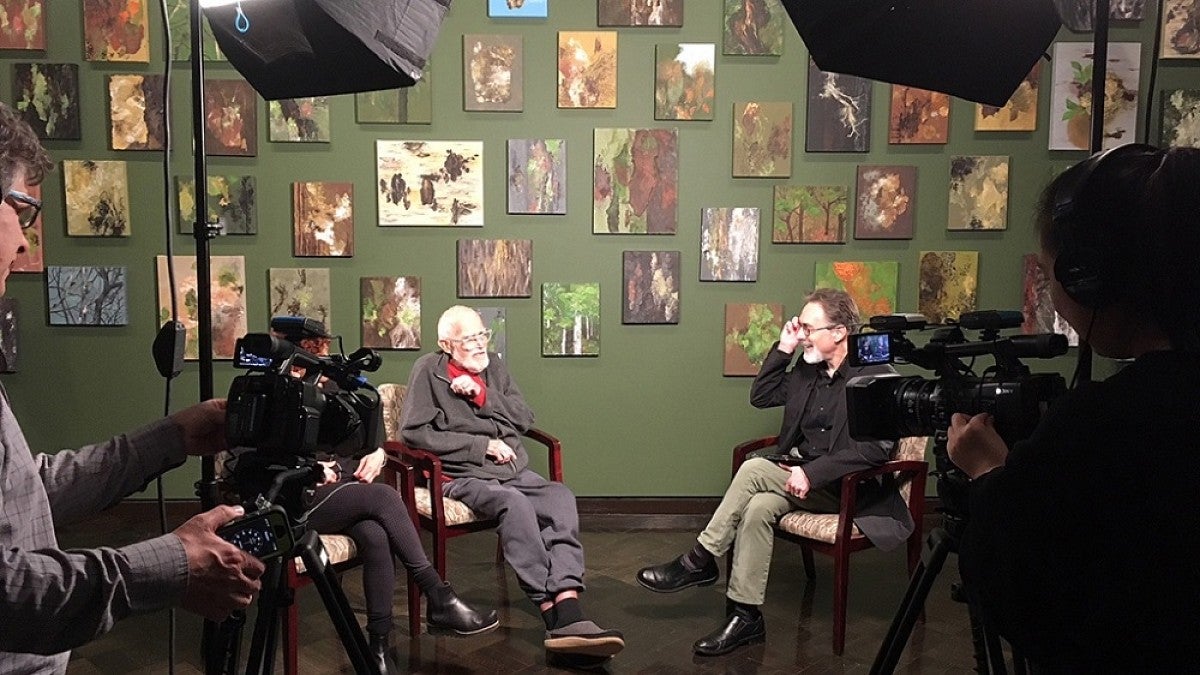Eugene-based artist Keith Achepohl died recently after a battle with cancer, but “Vision of Nature/Vessel of Beauty,” an exhibition of his work, remains on display at the Jordan Schnitzer Museum of Art through April 29.
Achepohl, along with Schnitzer executive director Jill Hartz, was UO Today’s most recent guest. In the interview, Achepohl talked about the exhibition and shared insight into his art and his lifelong connection with nature.
“Vision of Nature/Vessel of Beauty” showcases the deep artistic explorations of the natural world that Achepohl produced while secluded at “The Lake,” an artist’s retreat in Loleta, California, in 2011 and 2016.
“We were overwhelmed with how beautiful it was, just how intense and amazing these works were,” Hartz said.
Oregon-born artist Morris Graves established The Lake, located within 150 acres of ancient rainforest, before his death in 2001. Achepohl started following Graves’ career in college and applied for a three-week residency at The Lake decades later.
“When I got there I didn’t know, and I didn’t have to know, exactly what I was going to do there,” Achepohl said. “I wandered around that first afternoon and started doing a number of drawings of plants.”
Achepohl discovered a patch of skunk cabbage just outside his guest house. The plants became the focus of weeks of work as he painted their leaves in various states of decay.
“I love plants that are coming and going,” he said. “Life is coming and going. So really, all of this is about the life and death of plants. What we’re going through is life and death, and Graves, of course, dealt a great deal with all of that. That’s always been part of what I liked about him — he didn’t shun any of that. It’s very beautiful to be able to acknowledge all of that.”
Achepohl hopped between media, sometimes working with a pencil, sometimes with acrylic or oil paints. He was a Professor Emeritus at the University of Iowa, where he was the head of the printmaking program.
“I change media because every time I work on one media or another, I’m learning something, and art is about learning,” he said. “Art tells me what I’m thinking, art helps define who I am. And that, after all, is what being a human being is.”
The exhibition displays Achepohl’s explorations of the skunk cabbage and other plants and trees he encountered at The Lake, including intricately detailed close-ups of tree bark.
Achepohl’s intimate connection with nature began when he was a child. As an adult, he often encountered people who told him about walking and hiking in the forests of the Pacific Northwest. He liked to ask them about the details of the plants, trees, leaves and branches that they saw.
“Often they don’t know what they saw because they didn’t bother to look,” he said. “Oh, what a waste. It just becomes a kind of wondrous thing to me that these people haven’t really seen much. I hope that if people who look at these things get anything out of it that it’s that next time they go out there, look a little more closely. And find out that there’s more to see.”
For the full interview, go to the UO Today channel.
“UO Today” is a weekly half-hour interview program hosted by Paul Peppis, a UO English professor and director of the Oregon Humanities Center. Each episode features a conversation with UO faculty and administrators, visiting scholars, authors or artists.
It is produced by the Oregon Humanities Center in collaboration with UO Libraries’ Center for Media and Educational Technology. An archive of past interviews is available on the Oregon Humanities Center’s website or on their YouTube channel.
—By Sarah Eddy, University Communications


